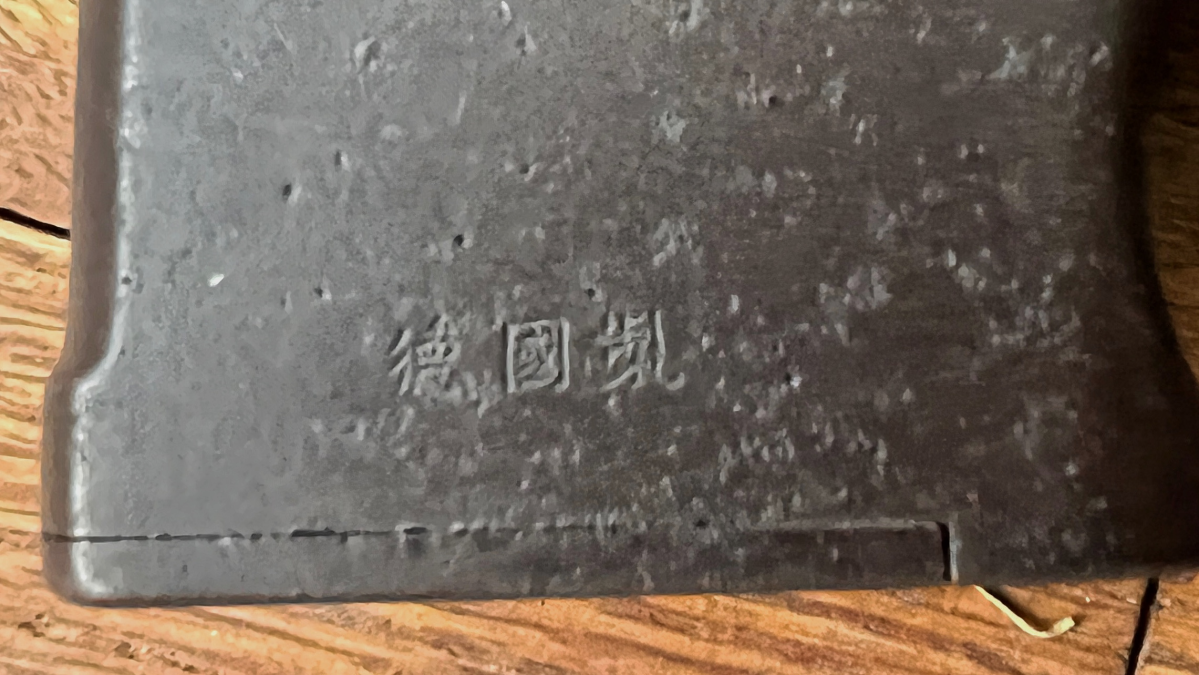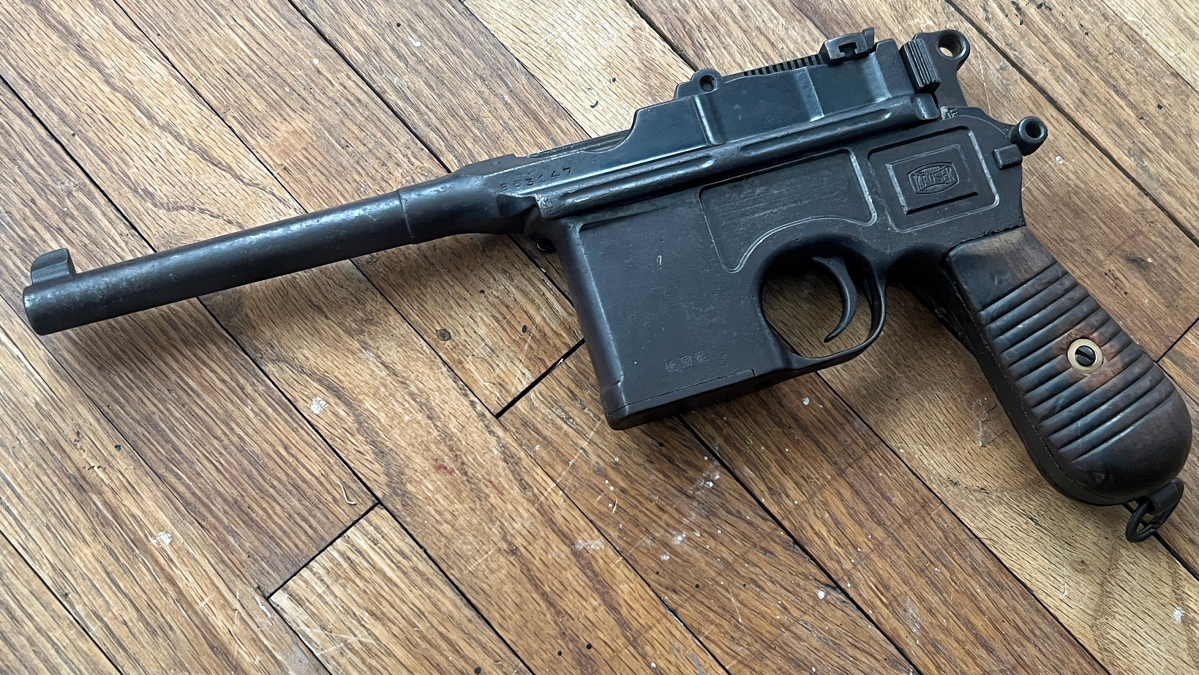Curious Relics #055: A Personal Favorite – The Mauser C96
Sam.S 01.04.23
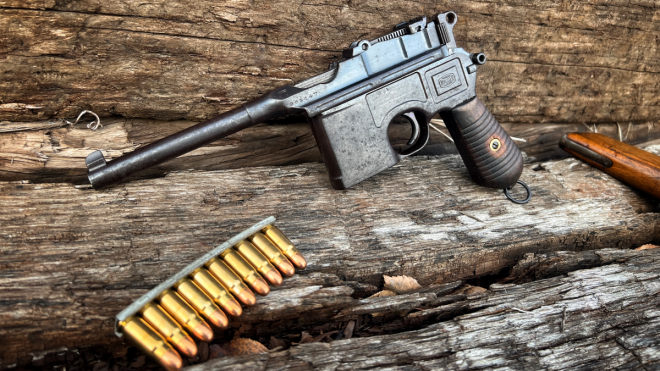
Welcome, if you are a newcomer to this fun bi-weekly segment of AllOutdoor.com! It has been a while thanks to the stacked-up holidays. Happy New Year everyone! The last time I had a little fun and made an “All I Want For Christmas – Curious Relics Edition” article. In that article, I listed a revolver, rifle, pistol, and shotgun that were on my Christmas list. Spoiler! Santa could not track that down in such a short time. Nonetheless, it was fun to be able to share aspirations and hopefully future content in this segment. As far as today goes we are back to business as usual and really kicking off the New Year right with an absolute gem of a pistol. The Mauser Construktion 96 otherwise mostly known as the Mauser C96. Let’s dive right into the legendary Broomhandle!
Welcome to our recurring series of “Curious Relics.” Here, we want to share all of our experiences, knowledge, misadventures, and passion for older firearms that one might categorize as a Curio & Relic – any firearm that is at least 50 years old according to the ATF. Hopefully along the way you can garner a greater appreciation for older firearms like we do, and simultaneously you can teach us things as well through sharing your own expertise and thoughts in the Comments. Understanding the firearms of old, their importance, and their development which lead to many of the arms we now cherish today is incredibly fascinating and we hope you enjoy what we have to share, too!
The Birth of Autoloading Handguns
In the 1890s there was an explosion of autoloading handguns popping up around the world. This was mainly to do with the rise of smokeless powder which made its appearance in 1884. With smokeless powder, an autoloading mechanism was far more practical and possible. Less fouling and corrosion meant that the gun would not quickly turn into a paperweight. These new handguns all catered to different things such as military adoption or self-protection but the downside is most were short-lived, finicky, and totally proprietary. Taking a step back it is obvious why. They were the first real-deal handguns! No one knew what an autoloading handgun was supposed to be but they knew they could make them and potentially stumble across a design that would change the world.
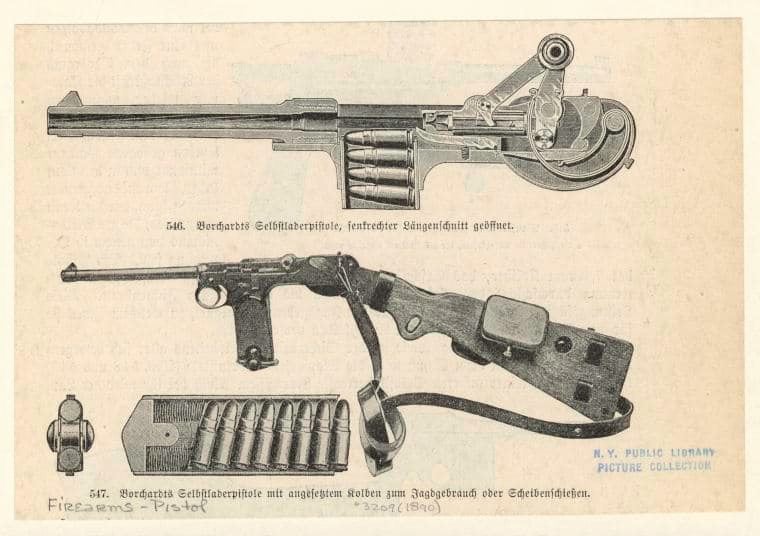
N/A [Photograph found in Cody Firearms Museum Facebook Page]. (2021, February 26). In 1287635042 949192828 C. (Author). Retrieved April 4, 2021, from https://www.facebook.com/CodyFirearmsMuseum/photos/pcb.3582502148640605/3582501858640634/ (Originally published 2021, February 26)
Designs such as the Borchardt C93 had found early success. If you were to take a look at the C93 today you would find that despite its modern features such as a detachable magazine, it feels just as awkward as it looks and were far less common than people believe even though it is thought of as the first “commercially successful” autoloading pistol. The C93 is significant to today’s topic since its cartridge was highly influential to many handguns that came after it. Most notable examples would be the Luger, Bergmann handguns, TT-33, and of course the C96. All used bottlenecked cartridges and all because Borchardt did it first (or at least most successfully) and from then on everyone’s new cartridge influenced another.
History Abridged: The Mauser C96
The Mauser brand itself (Waffenfabrik Mauser) was well established by the 1890s due to its influence in rifle technology starting in the 1870s. The Mauser family was a long line of inventors, gunsmiths, and designers. Most notably for today anyway, there were two main Mauser brothers that “made” Mauser a brand. Paul (1838-1914) and his older brother Wilhelm (1834-1882) manufactured successful rifles that would come to be used all around the world. In the late 1870s, the pair would create the Mauser 1878 or Zig Zag as it is referred to today. It, unfortunately, arrived late to military trials, and Germany was stuck with the admittedly awful Reichsrevolver. Out of the Two brothers, Paul always exhibited a bit more inventiveness and want for innovation and creation. In the late 1880s and early 1890s, he would tinker with a new manually operated handgun design that used a ring trigger but few were made and he quickly lost interest as the autoloading industry began to boom.
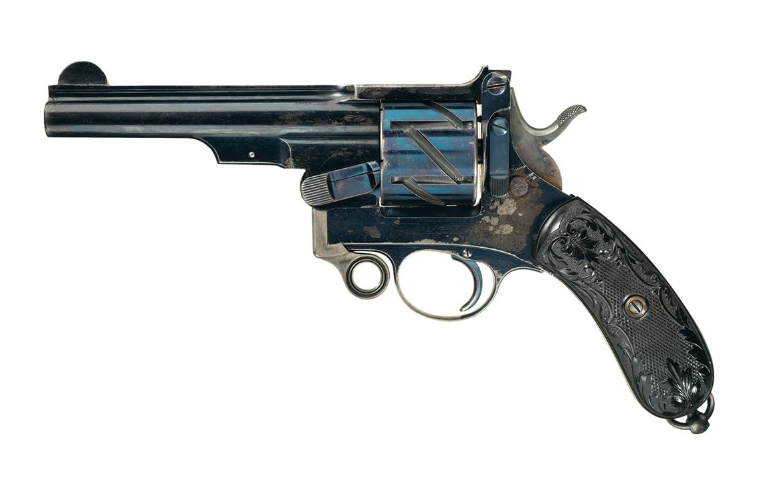
Lot 1613: Mauser 1878 Revolver 11 mm. (n.d.). Rock Island Auction Company. photograph. Retrieved February 28, 2022, from https://www.rockislandauction.com/detail/67/1613/mauser-1878-revolver-11-mm.
Note: Before we dive deeper I would like to mention that a lot of Mauser C96’s developmental history is not entirely known or confirmed. Some aspects are speculation but all mentioned below (if any) are universally agreed to be probable. That all being said new information after the publication of this article may surface though it is unlikely.
It is widely believed that Paul Mauser himself did not invent or design the gun that would become the C96. He did however look at other pistol designs and patents that he was privy to and make notes and tweaks to work around them. It is also widely accepted that members of the Mauser company staff and Research and Development department basically created the major stepping stones that would become the Mauser C96. One such clue is Fidel Feederle who was Paul Mauser’s second in command and head of research and development and claimed that he and his family would discuss the design over dinners and eventually they took their ideas to the factory. There are some claims that they did this unbeknownst to Paul until they were caught and told not to do it on company time but I am unsure how much of that is conjecture vs reality. Beyond all the mystery it is very obvious that the commercial success of Hugo Borchardt’s Model C93 and its bottlenecked 7.63 cartridges must have made an impression on the Mauser company because as of 1893 the first approved steps to make a pistol began
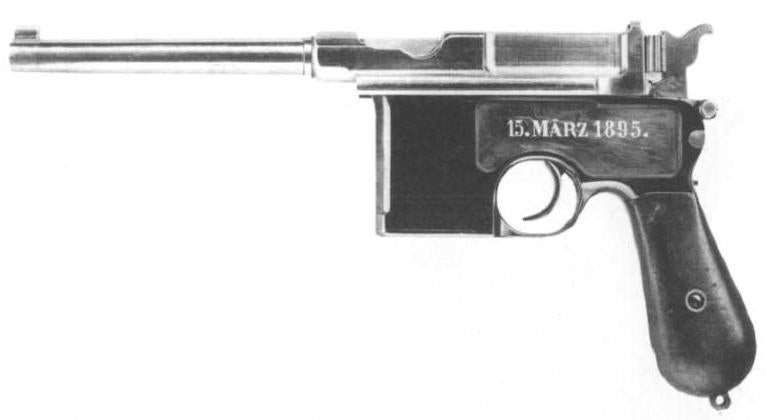
By 1895 the Mauser company had a working prototype and it would be patented the same year on December 11th. Later, in 1897 a patent would be accepted in the United States. These pistols were short recoil operated, hammer fired, stripper clip loaded pistols. Prototype pistols are easy to spot since they have fixed rear sights and spur hammers. The first real production pistols were popping up in 1896 and 1897 and these few would be marked “System Mauser”. These pistols are discernable from later ones (beyond the very different namesake on top of the barrel) due to their flat side appearance, solid uninterrupted guide rails, cone hammer, and long extractor. An estimated number of these first pistols made is around 360; it is speculated that current existence is in the teens.
Note on Cartridge: The Mauser C96’s initial and most common chambering was for the bottlenecked 30 Mauser cartridge or 7.63x25mm as it is called metrically. It was derived directly from the Borchardt C93’s cartridge. To simplify, Mauser took the C93 cartridge and added a lot more power to it since the new Mauser pistol was more robust. Funny enough, the first 1895 prototype pistols were chambered for the Borchardt cartridge. The new 30 Mauser’s high-velocity nature made it fire very far very flat but due to its low mass(typically 85 to 90 grain), it lacked “stopping power” at range. This peppy little 30-caliber cartridge held the title of “High-Velocity Pistol Cartridge Champion” until the .357 Smith & Wesson Magnum was introduced in 1935.
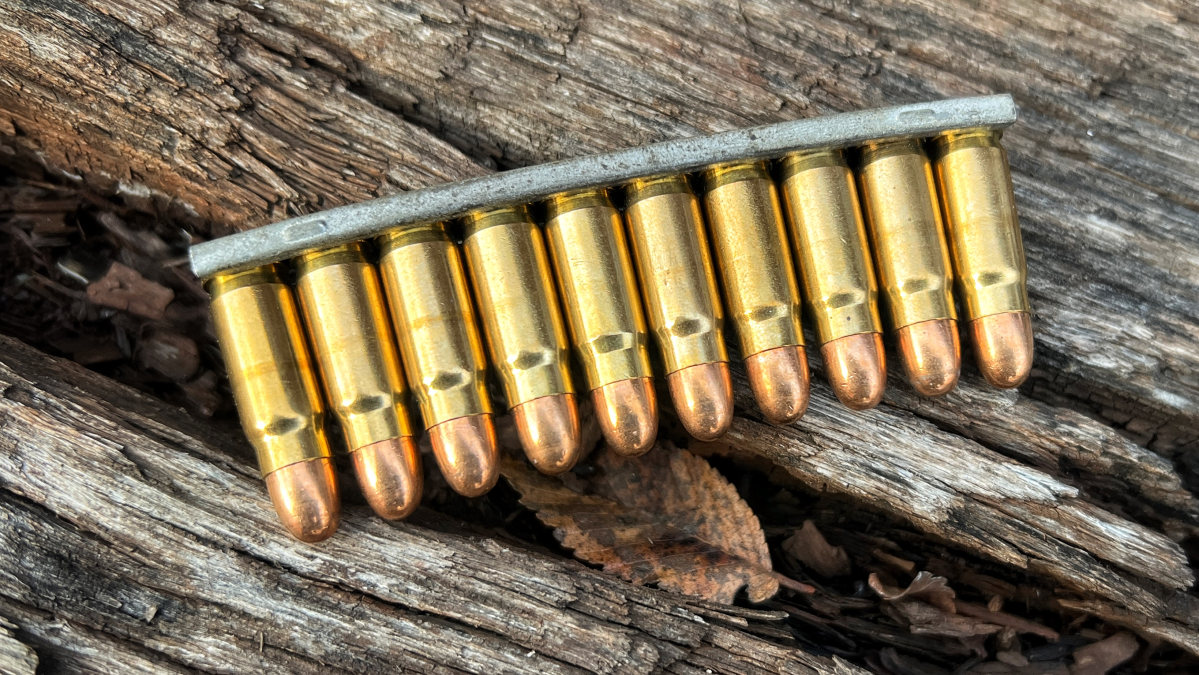
Jumping ahead just a bit, the Mauser Construktion 96 was gaining traction and gaining features like adjustable sights, standardized ammunition, and accompanying shoulder stocks that doubled as holsters. Two early cataloged variants included a C96 with a 20-shot magazine (made until 1908) and one with a six-shot magazine and fixed rear sights (made until 1913) to save on size and weight. Both are extremely rare today. The C96 was showcased to military officials from all over Europe both officially in trials and unofficially, oftentimes shown by Paul Mauser himself. Wilhelm II of Germany even got some hands-on time during a large demonstration and really liked the design. By late 1897 the Mauser C96 scored its first military contract with the Ottoman Empire which basically paid for their tooling to make this a full-fledged production gun. The C96 would see sales all over the world and would license, import, and export to several companies (unlicensed copies would later pop up).
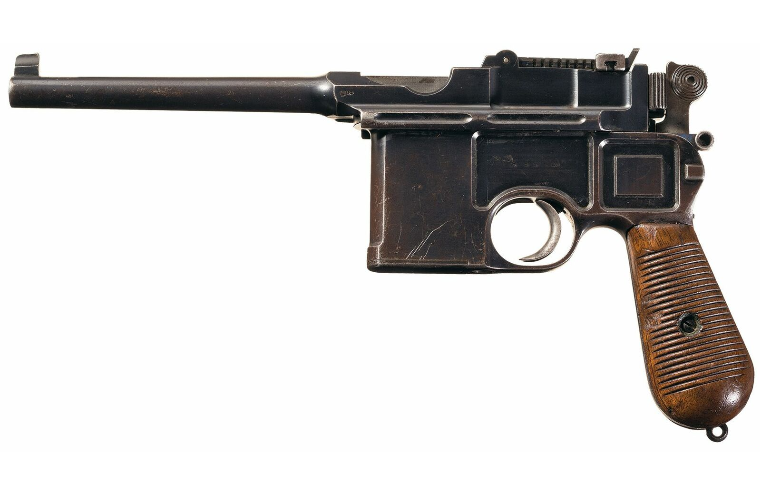
Lot 3448: Antique Cone Hammer Mauser Broomhandle Pistol – Antique Mauser Model 1896 Cone Hammer Broomhandle Semi-Automatic Pistol. (n.d.). Rock Island Auction Company. photograph. Retrieved January 3, 2023, from https://www.rockislandauction.com/detail/74/3448.
In the late 1890s Mauser and its larger umbrella company DWM (very long story) worked hard to please the German military and hopefully get their C96 pistol adopted. Unfortunately for Mauser in 1900 Georg Luger introduced his toggle-locked luger pistol. This pistol was an enhanced and perfected version of Borchardt’s C93 design. It originally used the 30 Luger cartridge (another derivative) but would eventually be chambered for the 9mm Luger which is a mainstay by today’s standards. These pistols would initially be adopted by the German Navy in 1904 and in 1908 the German army followed suit. The C96 would never be adopted as Germany’s standard issue sidearm. However! It would still be issued as a substitute for the Luger in some situations (supply chain or otherwise). The Mauser C96 pistol would see action in World War One and would also be modified and produced (starting around 1916) in that new fancy 9mm cartridge. These 9mm variants would go on to have a large red painted “9” on both wood grips since both guns were extremely similar and could be mixed up. Beyond the change in grips the rear adjustable sights were changed as well with the 30 caliber ones going out to an optimistic 1000 meters and the 9mm ones would only be slated for a max of 500 meters.
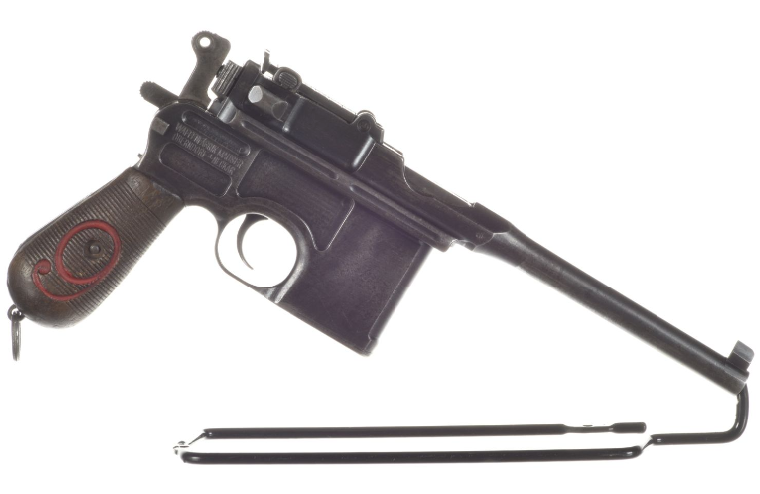
Lot 4367: Mauser Broomhandle “Red 9” Semi-Automatic Pistol with Holster. (n.d.). Rock Island Auction Company. photograph. Retrieved January 3, 2023, from https://www.rockislandauction.com/detail/1039/4367/mauser-broomhandle-red-9-semiautomatic-pistol-with-holster.
After World War One the manufacturing of these pistols was cumbersome due to the Treaty of Versailles which both limited the production of any sort of small arms but also hindered their features. Many pistols at this time would come to be referred to as the 1920 variants since they were forced to have shorter barrels and fixed rear sights. With all of the new restrictions a lot of Mauser C96 production would be outsourced (it is estimated that at least 50% would come out of China).
The last gasp in C96 production happened in the late 1920s and early 1930s with the “Model 1930” as it is referred to both then and today. These were much more commercialized guns with nice glossy blued finishes, nitre blued small parts, and small “enhanced” safety features. The Mauser C96 would see use in the Second World War but never in an official capacity. Countries such as Turkey, Persia, Austria, Italy, Finland, China, Indonesia, Norway, France, and Thailand would all utilize the C96 in varying roles. Its production would sadly end in 1937 due to the Sino-Japanese War and decreased sales. A decent amount of C96 pistols in several variants were still in Mauser’s inventory when World War Two broke out and they would subsequently find their way to battlefields but not because of the German government but by soldiers purchasing them.
End of Part One: The Mauser C96
In 1984 the United States government ruled to allow the importation of World War One and World War Two handguns. Many C96 pistols became available and are fairly commonly found today. Due to video games, movies, and other forms of pop culture, their prices have escalated dramatically, and just getting a shooter condition C96 can set you back a good chunk of change. Most will look similar to mine in that the finish will be so/so, the actions will work perfectly, rust and hitting will be present under the grips, and the bore usually shot out. I had to get my barrel relined. Big thank you to Redman’s Rifling & Reboring! You do excellent work, sir!
In closing, I hope our Curious Relics segment informed as well as entertained. This all was written in hopes of continued firearm appreciation and preservation. We did not just realize how guns were supposed to look and function. It was a long and tedious process that has shaped the world we live in. So, I put it to you! Is there a firearm out there that you feel does not get much notoriety? What should our next Curious Relics topic cover? As always, let us know all of your thoughts in the Comments below! We always appreciate your feedback.
